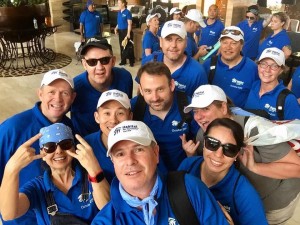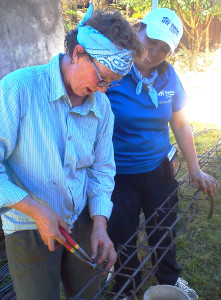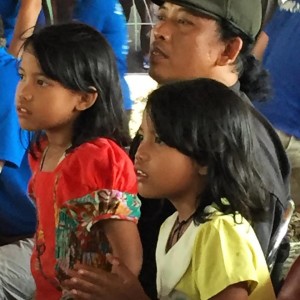When I uttered my secret aloud, little did I know that it would lead to an exchange that would change my life forever.
Following a trip to Fiji with my partner Karen Green in May 2016, I let it be known that I found the visit not as bad as what I can remember during my early life as a youngster in Indonesia. Hiring a car and driving in a foreign third world country was disastrous, as I don’t understand the local mind set and I was not used to the opportunistic style of driving. On my return, I had lots of stories to share with my family about that and many other experiences that I held close to my chest, some of which, I will release soon, therapeutically, in a Word Press blog. (http://jindy.portaloz.tv/).
Sharing some of these stories with my sister on my return, she insisted that it’s time to visit the demons in my Indonesian closet by investing in the well timed charity – Habitat For Humanity – an over 40 year old program that creates funds for the building of houses for underprivileged people around the world. In particular there was a build poised to take place in Indonesia dubbed “Rock The House” and inspired and promoted by the well known Suze DeMarchi of the Australian rock group “The Baby Animals”.
whilst hiding my fears, I must admit, the adventurous side of me, was vaguely intrigued with the idea. When it was presented to me, I was against any such decision to return to a place that I fled from in the mid 1950s. The time is depicted in the well known movie “The Year of Living Dangerously“, starring a young Mel Gibson and Sigourney Weaver, during the overthrow of President Sukarno. Supported by the current demonstrations in Jakarta, the feelings and fear of those times have never left me.
Not having much time to decide and commit to the next build in Indonesia was, in hindsight, a good way to move forward. “Just do it” said Karen in harmony with my sister Catherine.
The fact that I had the opportunity to witness where the money goes was irresistible. The most intriguing unknown was the promise to build 25 houses in a week with 300 volunteers, requiring no skills at all. This was something to see to be believed. Like a magic act, this alone was enough to keep my interest and lead me to the submission of my sister’s suggestion. So I began to examine my intentions and investigate my options.
“what is in it for me?” I asked. Giving something that I can afford makes me feel good. So now if anybody asks why?… the answer would be… “it’s because I can”, and it is a paid-for guided tour while the program watches your back and keeps us all safe.
This is where I got a chance to give, not only money that Karen and I could afford, but to follow the money trail and be part of the experience of giving; seeing the benefit of our donation underpinned by our toil.
Choosing “Habitats for Humanity” gave us all a chance to immerse ourselves in a different and burdensome way of life, while, at the same time, being given a chance to reason why we are witnessing the inherent happiness of the locals, that is evidently nurtured in their society.
if Karen and I can return and submit a public report highlighting the value of all your donations, then we are closer to achieving a healthy exchange of awareness, allowing both cultures a chance to bare witness to a life changing experience.
Hence I have committed to writing about my exchange to be submitted for publication in the Snowy River Echo and Karen has been requested to delivering her own take of it in a presentation to the Jindabyne CWA (Country Woman’s Association) on our return.
“So what is in it for them?” I also asked. The average cost of each build in Yogyakarta is $3000au that is around 30.2 million Rupiah. Yes, one needs to be a millionaire over there to come close in comparison to what we can provide for ourselves here in Australia.
I went on to ask many more questions like; “what is a house?… what does a home mean to me or you?… That is, if we can afford one? I know that in the Indonesian lifestyle, it may be the feeling of belonging…. to a community… with some degree of confidence in humanity. It is where you interact with others that share your living space. It is a life long family possession, something physical that could be passed down to future generations along with attached memories, like an heirloom. Yes this could be a valuable possession which enables sustained emotions and attachments that could be a powerful influence on descendants and the state of ones being. All this is part of their family bonding nature which is followed through to the community cemetery. There is also their superstitions, which I will also leave for another time to enter on my blog.
I remember the bare feet, dirt floors, leaky roofs, poor sanitation, primitive methods with no electricity. How can you or I even contemplate life in these conditions? With all these questions that I could not satisfy then, maybe, by volunteering my personal labour that would support yours and my monetary donation, we will be able to create a win win and actually make a difference while searching for answers?
With the commitments set in motion it was time to study the facts:
The Build site was named Srunggo 1, located in Selopamioro village within the surrounds of South East Imogiri in Bantul District, 30 km out of Java’s’ central province YogYakarta, in the country of Indonesia.
Looking at it today, the regions historic position, in brief, is a society still settling from turmoil delivered by differing colonialists in separate passages of time and affected by its geographic location amongst volcanic activity and positioned along a historic world trade corridor. Not only enduring the gauntlet of historic events, this region is also influenced by staunch religions as a legacy from varying occupying societies and now renders a strict code of conduct and ethics.
Any society having to manage the legacy of such turbulence would surely be blessed with tolerance and prudence. This, essentially Javanese community, inherits unhindered ancient talents and attributes, which are simple and effective, brought about by the necessity to survive simply.
The Team The Build The Family
Reflecting on October this year, we were transported by minibus and arrived on site as part of the 11 person team allocated to commence our part of the project. The tasks were to demolish the existing building, dig the trenches, tie the reinforcements, lay the rocks as the foundations with the reinforcement, lay the preformed concrete brick walls and insert the architraves, and pour the concrete floor, render, then paint the walls. The procedure was illustrated on the side of the adjacent building.
On the average, we started working at 8:00 am, worked for 4 hours with one break before lunch. Lunch break was around 12:30pm and went for around an hour. We continued working for a further 2 hours, with one break in-between. Hmm… yes, after the first day It then became evident to me that completion in the allocated week was unachievable, especially when every afternoon, we encountered a monsoon storm. Consequently we were retuned, daily, like drowned rats, to where we were all staying in one of the finest hotels in the country. However, we were made to feel as though we achieved miracles, especially after pushing ourselves in that tropical heat.
It was an experience that will remain with me indelibly and with the affection toward all involved that brought this so cleverly about. How effective we were as labourers did not matter. It was the life changing exchange of interaction with people of our neighbouring culture, giving us a glimpse of life and the struggles in another world.
While reminding us how good we have it in our own country, with technology, opportunity and wealth, theirs is a simple existence that has no need for our trappings and struggle to maintain a happy way of living. it made me appreciate what I have and now I can see the allure of a simpler way of life. Where I was disenchanted with my earliest memories of Indonesia I have now rid my ghosts and eased my fear by seeing the possibility of having a safer existence there.
The little that we gave in monetary donations have gone a long way in this economic exchange, as labour is cheep while materials are unaffordable. We gave what we could afford and underpinned it with our labour and they gave us the unforgetable interaction which was worth a lot to us and the experience will stay with me forever.
And if anybody asks me “was it worth the investment?” I would tell them that I sincerely recommend donating, and even go so far as to recommend investing ones time to experience this life changing exchange.
Summing up, I will say “we came to help and we left with a whole lot more than we gave”.




Pingback: Blangkon Yogyakarta | Jindy